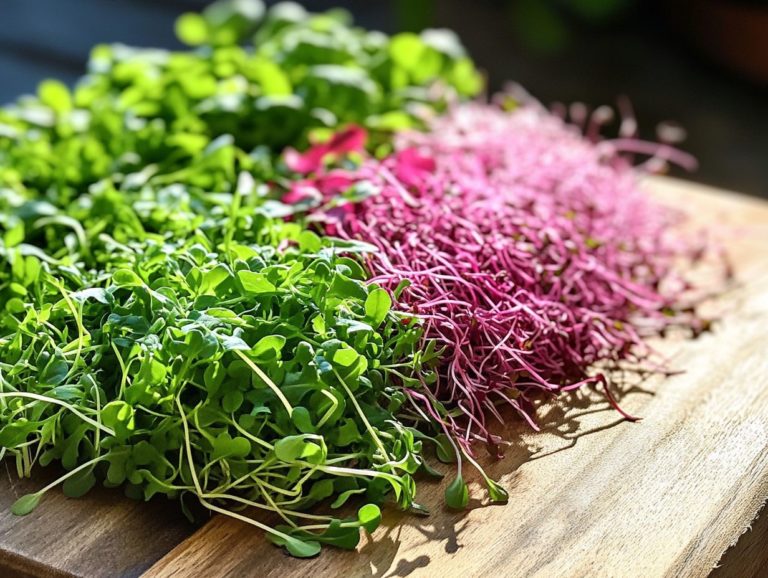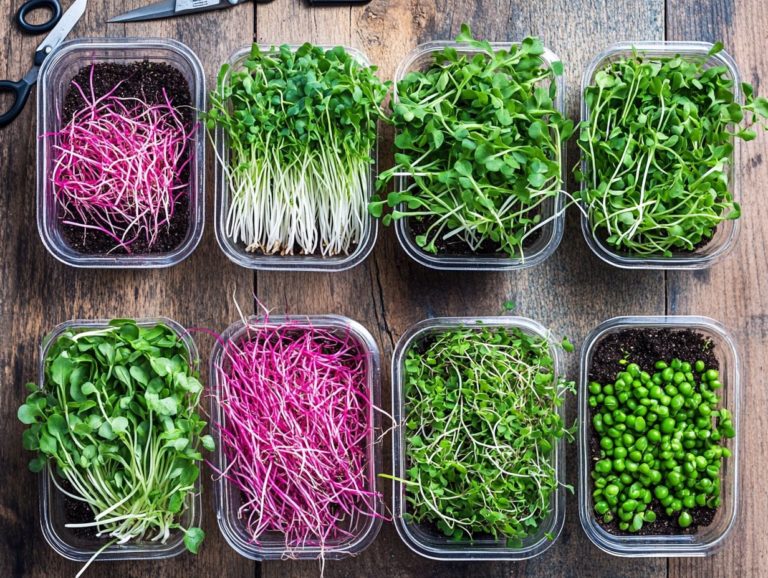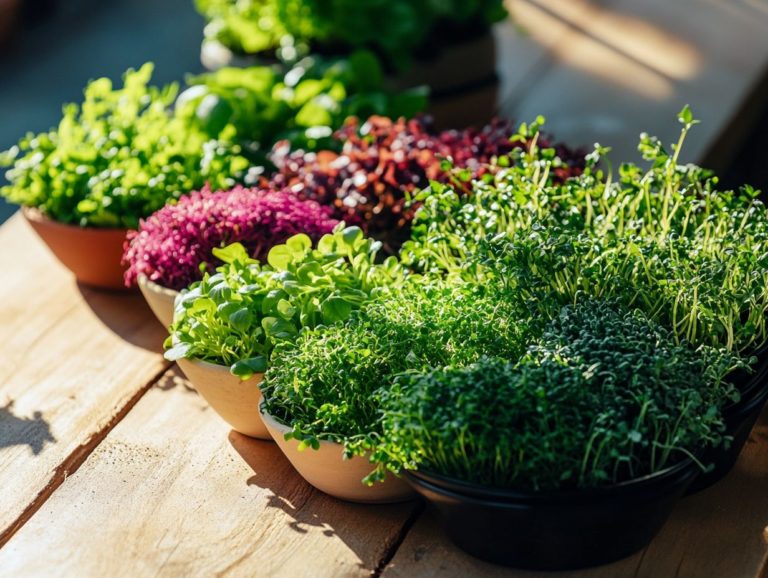The Role of Microgreens in Holistic Health
Microgreens have surged in popularity, not only for their vibrant colors and delightful flavors but also for their remarkable nutritional benefits. They showcase a powerful punch in the health foods category.
These small greens are full of nutrients like vitamins and minerals, making them a true powerhouse for both physical and mental well-being.
This article explores what microgreens are, the essential nutrients they provide, and how they can enhance your overall health, especially in managing conditions like Type 2 diabetes.
You ll also find practical tips for growing microgreens and incorporating them into your meals, along with crucial safety considerations to avoid foodborne illnesses.
Discover exciting ways to boost your health with microgreens!
Contents
- Key Takeaways:
- Understanding Microgreens
- Nutritional Benefits of Microgreens
- How Microgreens Support Holistic Health
- Growing and Incorporating Microgreens into Your Diet
- Potential Risks and Precautions
- Frequently Asked Questions
- What are microgreens and how do they benefit holistic health?
- What specific nutrients do microgreens provide?
- How do microgreens promote overall well-being?
- Can microgreens aid in disease prevention?
- Are there any specific microgreens that are especially beneficial for holistic health?
- How can I incorporate microgreens into my diet for optimal health benefits?
Key Takeaways:
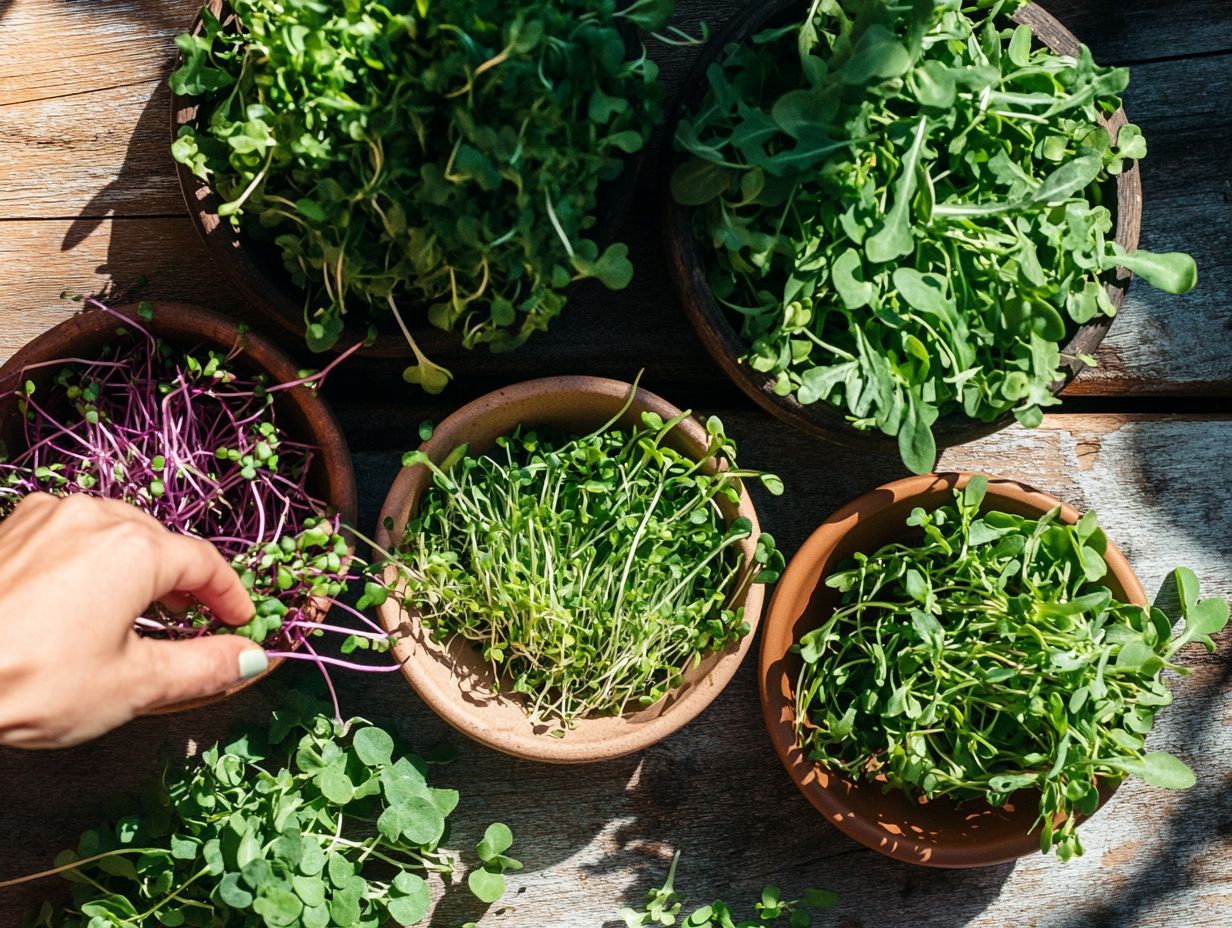
Understanding Microgreens
Learning about microgreens can help improve your diet with nutrient-dense foods and leafy greens from the Brassicaceae family. These edible greens deliver a burst of flavor and provide significant nutrient benefits, including vitamin C and sulforaphane.
Harvested at an early growth stage, they enhance a wide range of culinary creations, making them a perfect choice for health-conscious individuals. Embracing the role of microgreens in sustainable eating when growing microgreens offers an environmentally friendly option that supports both personal health and the planet.
What Exactly Are Microgreens?
Microgreens are young plants harvested just after the first true leaves have emerged. They deliver an impressive burst of flavor and nutrient density, making them popular in gourmet dishes.
These tiny greens, from micro arugula and broccoli to radish and edible flowers, present an extraordinary array of flavors and colors. With a rapid growth cycle of just 7 to 21 days, they appeal to home gardeners and culinary enthusiasts alike.
Rich in vitamins, minerals, and antioxidants, microgreens are increasingly sought after in health-conscious diets, contributing to digestive health and cognitive function.
Their allure extends beyond taste; they can enhance the nutritional profile of salads, sandwiches, and smoothies, transforming ordinary meals into health boosters.
Nutritional Benefits of Microgreens
Microgreens offer a variety of nutritional benefits that can elevate your overall health. They are essential for a balanced diet, especially for those looking to manage iron levels and prevent conditions like heart disease. Bursting with concentrated nutrients, these vibrant greens are renowned for their richness in vitamins especially vitamin C and essential minerals like iron.
They also contain a diverse range of plant nutrients and antioxidants, playing a vital role in enhancing cognitive function and promoting digestive health, making them a staple in healthy eating patterns.
Key Vitamins and Minerals Found in Microgreens
Microgreens are a treasure trove of essential vitamins and minerals. They boast impressive levels of vitamin C, iron, sulforaphane, and lutein.
Vitamin C boosts your immune system. It helps your body fight infections and may prevent cancer. Research shows that sufficient vitamin C can actually shorten the duration and severity of respiratory infections.
The iron in microgreens is vital for oxygen transport in your blood. It helps combat anemia and supports your energy levels. Studies published in the ‘Journal of Nutrition’ reveal that iron deficiency can lead to fatigue and diminished cognitive function. This highlights the importance of incorporating iron-rich foods into your meals, especially for those with existing health conditions like Gastroparesis.
Sulforaphane is a compound derived from certain vegetables and often found in microgreens. It has garnered attention for its potential anti-cancer properties. Research indicates that it activates detoxifying enzymes in your body, which help eliminate harmful substances.
Lastly, lutein is well-regarded for its role in promoting eye health. It protects neural tissues and may help prevent chronic issues like macular degeneration. By adding microgreens to your diet, you can tap into these powerful nutrients. For more information on their benefits, check out why microgreens are essential for a balanced diet. This helps mitigate chronic health concerns such as Alzheimer’s disease and heart disease.
How Microgreens Support Holistic Health
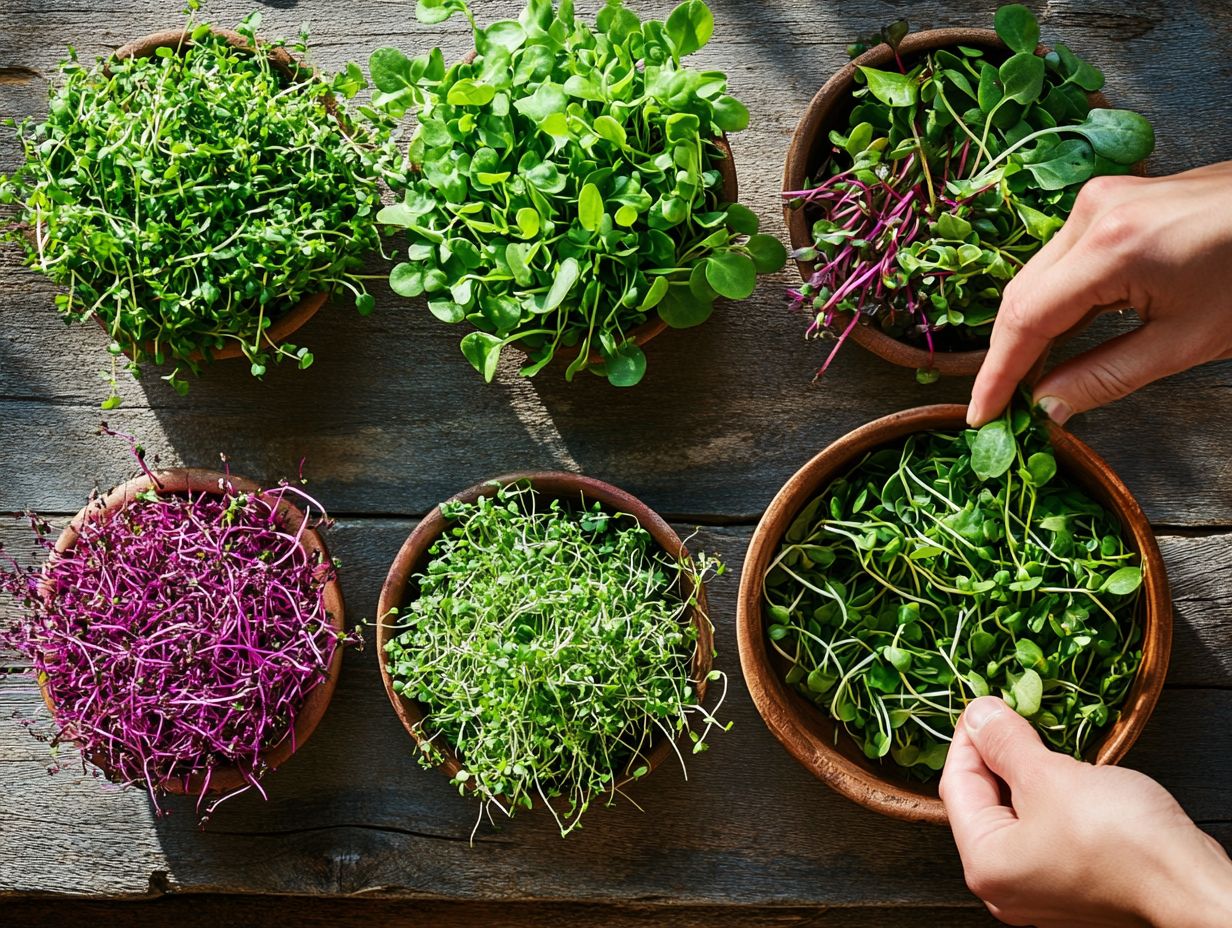
Microgreens enhance your holistic health. They provide a wealth of benefits that positively influence both your physical and mental well-being. This contributes significantly to a balanced, plant-based diet.
With abundant antioxidants and phytochemicals, these tiny powerhouses not only strengthen your immune system but also promote digestive health. This makes them essential for a balanced, health-conscious diet.
Impact on Physical Health
Microgreens can significantly impact your physical health. They enhance immune function and digestive health through superior nutrient absorption.
Research consistently reveals that these tiny powerhouses are nutrient-dense. They are brimming with vitamins and antioxidants that help combat oxidative stress and inflammation. A study published in the Journal of Agricultural and Food Chemistry highlights that certain microgreens can contain up to 40 times more nutrients than their mature counterparts. For more insights, check out understanding microgreens and their health advantages.
This remarkable difference can support various bodily functions, from boosting cognitive abilities to fortifying the cardiovascular system.
To enjoy the benefits of microgreens, wash them thoroughly. Always buy from trusted sources to prevent foodborne illnesses.
Impact on Mental Health
Microgreens boost mental health and cognitive function. They are packed with essential nutrients, crucial for brain health.
These tiny greens are nutrition powerhouses, brimming with significant amounts of vitamins, minerals, and phytochemicals. This is particularly beneficial for individuals at risk of conditions like Alzheimer’s disease. For example, broccoli microgreens are especially rich in sulforaphane, celebrated for its neuroprotective properties. Meanwhile, beet microgreens provide nitrates that promote improved blood flow to the brain, making it essential to understand the science behind microgreens and health.
By incorporating these nutrient-dense microgreens into your daily meals, you cultivate a balanced diet. You also embrace a holistic approach to health, reinforcing the importance of health and wellness. This underscores the pivotal role of nutrition in nurturing emotional well-being and cognitive vitality, proving that health benefits extend beyond just physical attributes. For more insights, check out the top microgreen varieties for health enthusiasts.
Growing and Incorporating Microgreens into Your Diet
Growing and incorporating microgreens into your diet is a simple yet rewarding endeavor. It can elevate your culinary experience while fostering healthier eating habits through flavorful options and nutrient absorption. Whether you decide to cultivate your own or purchase them, these nutrient-dense greens can easily be added to a variety of dishes.
Microgreens not only enhance flavor but also provide numerous health benefits, making them a valuable addition to your meals.
Methods for Growing Microgreens
You have various methods available for growing microgreens, from soil-based systems to hydroponic setups, suitable for beginners and experienced growers.
Each method has its own advantages and challenges, allowing you to choose the one that best fits your resources and preferences. Soil-based systems require a quality organic substrate, trays with drainage holes, and a reliable light source. Hydroponic setups use nutrient-rich water solutions, grow mats, and specially designed containers to promote optimal root growth.
To successfully cultivate microgreens, ensure adequate light, maintain proper moisture levels, and monitor ideal growing temperatures. By perfecting these conditions, you encourage healthy plant development.
Embracing sustainable farming practices through microgreens boosts your nutritional intake and helps reduce environmental impact. This journey allows you to cultivate a rewarding balance between personal health and stewardship of our planet, especially when you consider why microgreens are superfoods you need.
Creative Ways to Use Microgreens in Meals
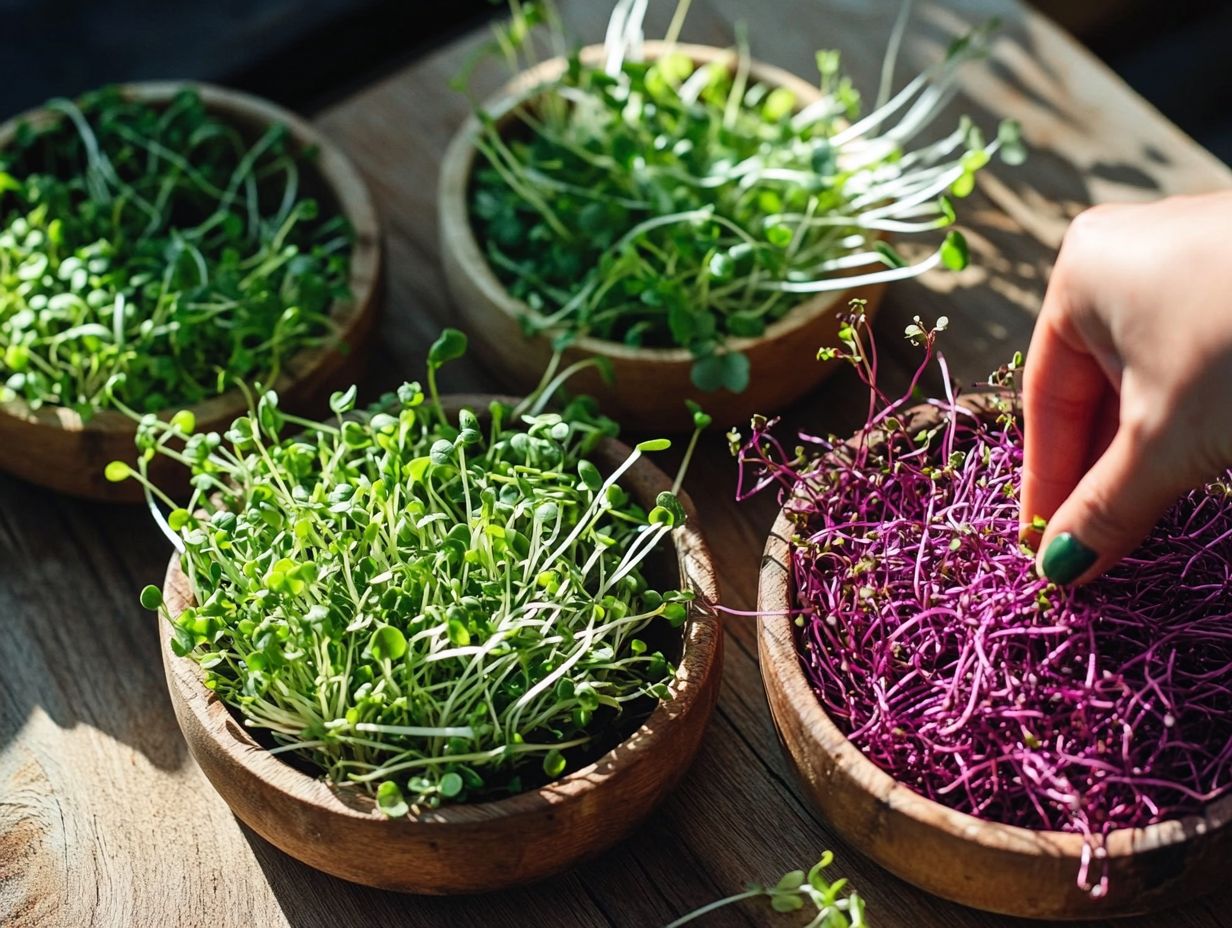
Microgreens offer many creative possibilities to elevate your meals, infusing them with distinctive flavors and a wealth of nutritional benefits.
Imagine tossing a mix of arugula and radish microgreens into a fresh salad. This not only enhances the visual appeal but also adds a delightful peppery kick that pairs beautifully with a citrus vinaigrette.
In sandwiches, consider swapping out traditional lettuce for the delicate crunch of basil or cilantro microgreens. They bring vibrant aromas that invigorate every bite.
These tiny greens also make striking garnishes for soups and entrees. Picture a creamy tomato bisque adorned with colorful sunflower microgreens, transforming a simple dish into a gourmet delight. Their versatility knows no bounds, positioning them as essential ingredients in both everyday cooking and elevated culinary masterpieces.
Potential Risks and Precautions
While microgreens provide many health benefits, it’s essential to remain mindful of potential risks and precautions, especially regarding food safety and allergy considerations.
Allergies and Contamination Concerns
Allergies and contamination concerns are important when enjoying microgreens. You ll want to pay close attention to food safety protocols.
Certain varieties, like arugula and radish microgreens, may trigger allergic reactions in some individuals, leading to itching, swelling, or gastrointestinal discomfort. Contamination can be a concern if proper handling or washing techniques aren t followed, exposing you to harmful bacteria or pathogens.
To mitigate these risks, wash microgreens thoroughly under running water and source them from reputable suppliers.
Be vigilant for any signs of wilting or discoloration, as these could indicate spoilage. This awareness helps ensure that microgreens remain a safe and nutritious addition to your meals, especially when you understand the health benefits of microgreens.
Frequently Asked Questions
What are microgreens and how do they benefit holistic health?
Microgreens are young vegetable greens harvested just a few weeks after sprouting. They are packed with nutrients and antioxidants, making them beneficial for holistic health.
Start your journey today by growing your own microgreens! It’s fun, easy, and a fantastic way to add fresh flavors and nutrients to your meals. For more insights, check out unlocking the antioxidant power of microgreens.
What specific nutrients do microgreens provide?
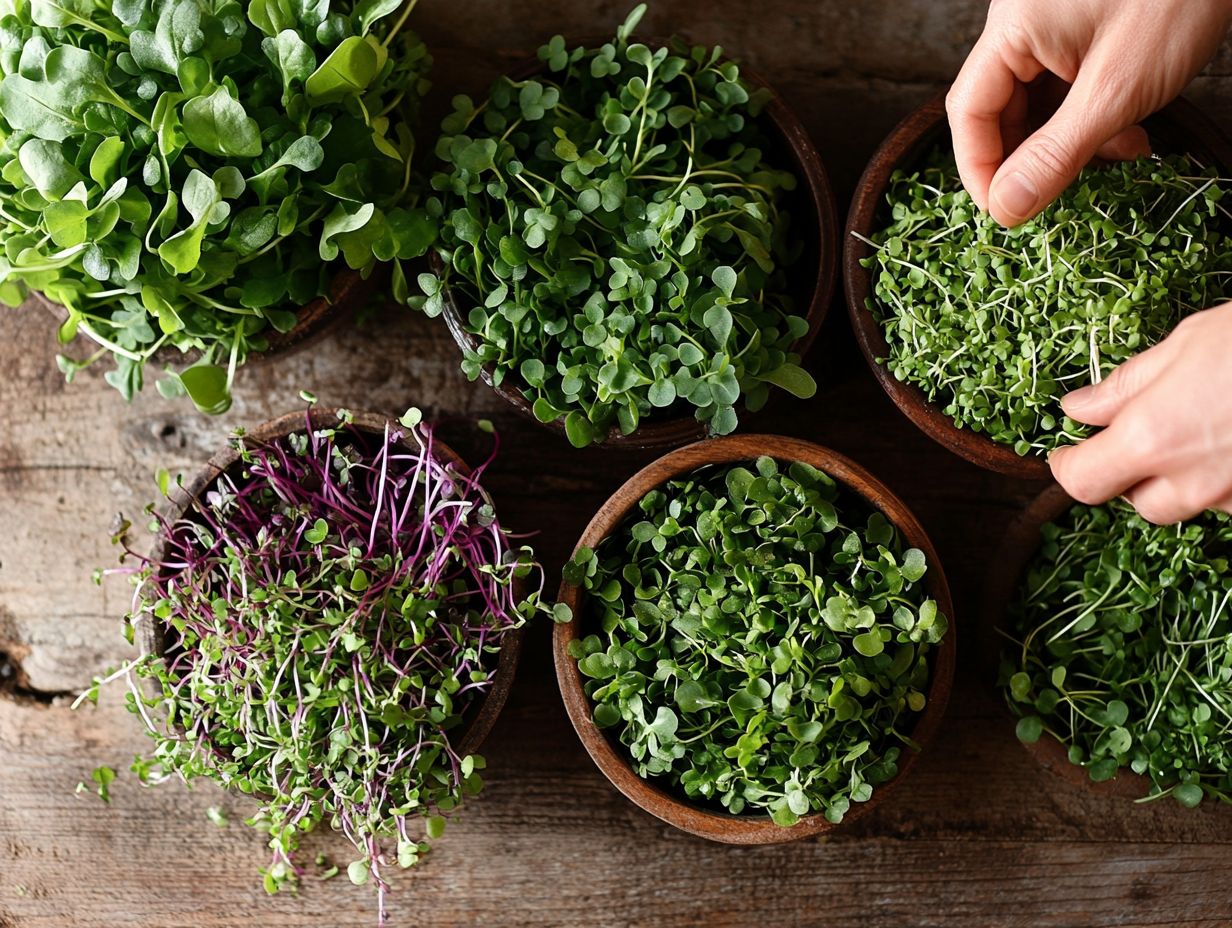
Microgreens are rich in vitamins, minerals, and nutrients found in plants. Some of the most common nutrients are beta-carotene, vitamin C, vitamin E, and potassium.
How do microgreens promote overall well-being?
Microgreens boost the immune system and improve digestion. They also help regulate blood sugar levels and reduce inflammation, which contributes to feeling great.
Can microgreens aid in disease prevention?
Yes, microgreens are packed with antioxidants that protect against chronic diseases like heart disease, cancer, and diabetes.
Are there any specific microgreens that are especially beneficial for holistic health?
Different microgreens offer unique health benefits. Broccoli, kale, cabbage, and radish microgreens are among the most nutrient-rich options.
How can I incorporate microgreens into my diet for optimal health benefits?
Don’t miss out on the incredible health benefits of microgreens! Add them to your salads, sandwiches, smoothies, and even use them as a garnish.



